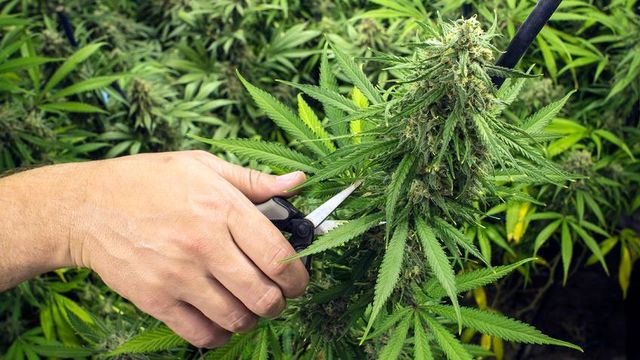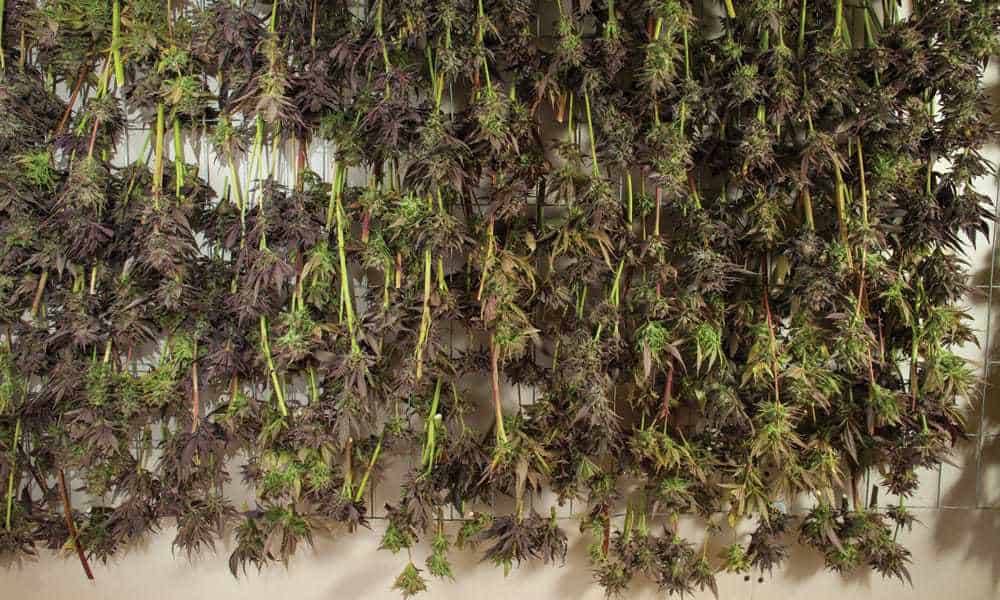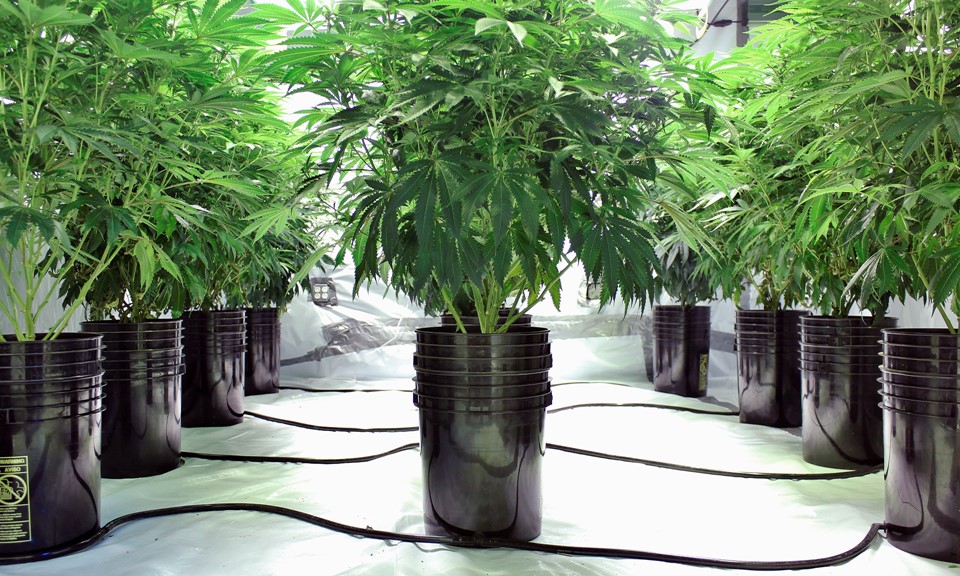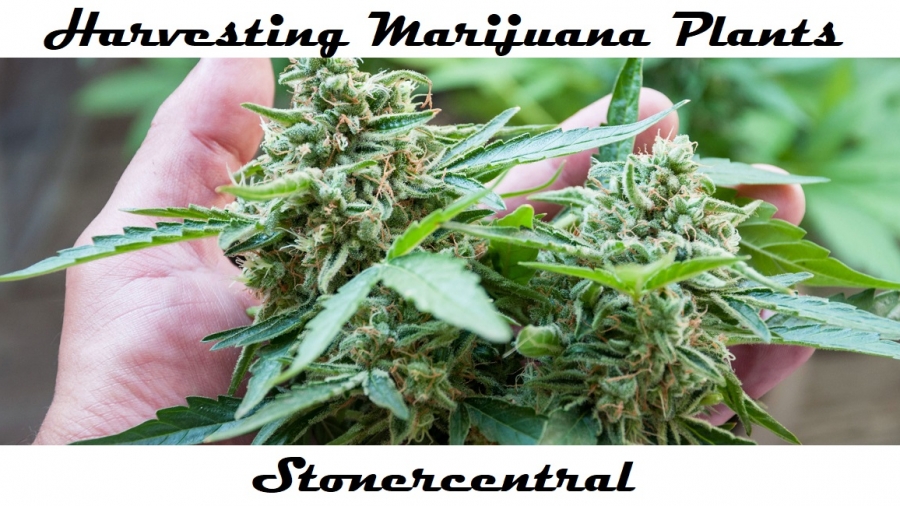It’s been months since that little sprout first popped out of the ground, or you put that delicate clone into some soil. You’ve watched your plants grow and mature, get bigger and develop buds. You can’t wait to get those buds off the plant and put them into your lungs.
Harvesting is usually the most exciting time when it comes to growing. All your efforts culminate in the moment when you cut down your crop. But the harvesting process isn’t just cutting down your plants and trimming buds. You’ll need to dry and cure plants before you can smoke them.
There are a few different ways to harvest, depending on whether you trim wet or dry:
- In wet trimming, you’ll cut down the plant, remove the buds off branches—called “bucking”—trim the buds, and then dry them, all in one sitting.
- When dry trimming, you’ll cut down the plant and hang it to dry for several days; then you’ll buck buds off branches and trim them.
But first thing’s first—how do you know when to cut down your plants?
How to determine when marijuana is ready to harvest
Because weed is a warm-season annual, if growing outdoors, harvest time comes between September and November in the Northern Hemisphere.
When growing indoors, harvest plants about 7-9 weeks after flipping them into flower. Some strains may take longer, some shorter; it will depend on the strain.
Outside, there is some variability—growers in Northern California can usually harvest into late October and November, whereas growers in the Pacific Northwest will likely need to pull their crops down by November and maybe even mid-October, before fall rains set it.
Know your local climate and talk to other growers in your specific area to see when they harvest marijuana.
But the best way to tell if your marijuana plants are ready to harvest, both indoors and outdoors, is to look at:
- Stigma: The hair-like strands that cover buds—they will turn from white to orange and will start to curl.
- Trichomes: They will turn from clear to opaque and then amber.
Keep in mind that top colas might reach maturity faster than bottom buds because they receive more light. You may need to harvest a plant when some buds aren’t quite ripe and some are ripe.

Additionally, information from the breeder or grower can be helpful in getting a rough estimate of when a particular strain should be harvested.
When looking at trichomes you’ll need a microscope. Handheld microscopes ranging from 30x-100x will work and can be purchased at any growing supply store.
During their change from clear to opaque to amber, trichomes reach their maximum THC content. After that, they begin to break down due to exposure to oxygen and UV rays, resulting in CBN (cannabinol).
Like other cannabinoids found in the cannabis plant, CBN has its own unique set of benefits—it has been linked to providing aid for insomnia, pain, and inflammation, and more. It does not, however, have any psychoactive effects.
Regardless of CBN’s benefits, most growers want to harvest buds before their THC degrades into CBN.
It’s important to note that every gardener has a different opinion on when to harvest their cannabis plants—some like to harvest early while others prefer later. When you harvest can also depend on other factors in life, such as your full-time job, the weather, etc.
Harvesting weed a week early or late probably won’t be the end of the world, but don’t let your plants sit around much longer than that.
Tips for determining when to harvest outdoor weed
Strains from regions close to the equator—sativas—need a long, seemingly endless summer to fully ripen, while strains from harsh, cold climates—indicas—tend to finish earlier. That being said, some indicas take a long time to finish and some sativas finish on the early side.
Follow the weather
With cannabis ripening as the season changes from summer to fall, chances are you’ll get some fluctuations in weather. Depending on your climate, there might be cold snaps or rainstorms.
This isn’t a disaster but it does require keeping an eye on the weather and possibly making a game-time decision on when to chop down plants, balancing peak ripeness with conditions that could compromise your harvest.
Cold temperatures
Most cannabis plants can sail through a light freeze—28-32°F for up to three hours—with no trouble. But a hard freeze, any lower temps or for longer hours, will most likely spell disaster. Frost damage causes ice crystals to form within plant tissue, damaging their cells.
Leaves will appear wilted before turning dark and crispy. The deeper the frost, the more of the plant that will get damaged.
Note that potted plants experience more severe temperature fluctuations than plants in the ground, making them more susceptible to frost damage.
How often do you harvest weed?
Indoor marijuana
When growing weed indoors, you can harvest as much or as little as you want. The sky—rather, your grow room—is the limit.
It can take anywhere from 3-8 months to grow a weed plant from seed to harvest, so you can fit in as much as four harvests of smaller plants, or one or two harvests of bigger plants each year.
More harvests mean you’ll have fresh, homegrown weed to smoke more often, but it will also be more work in cleaning up the space between harvests, trimming, etc.
You can even fit in more than four harvests a year if you start with clones or autoflower seeds, both of which shave off some weeks of the grow cycle.
Outdoor marijuana
By and large, cannabis grown outdoors gets harvested once a year. In most climates, seeds or clones will start in the spring, and you’ll harvest in the fall. In some tropical regions, you can squeeze in a second harvest in a year because of the climate.
You can set up your outdoor weed grow to have more than one harvest a year if you grow autoflower seeds. Autoflower weed plants have a shorter life cycle—they “automatically flower” when they get to a certain age, instead of beginning the flowering stage when sunlight starts to decrease in the sky.
Because of this, you can start growing a set of autoflowers early in the season, around March or April, harvest them in June or July, and then start growing a second set for harvesting in the fall. You’ll be able to have multiple harvests, but keep in mind that your plants will be smaller because they’re autoflowers.

You can also use light deprivation in a similar way. With light deps, a tarp is placed over a greenhouse to cut off the amount of light outdoor weed plants receive, giving you the ability to control your plants’ flowering cycle. As with autoflowers, this will allow you to fit in multiple outdoor harvests in a season.
The drawback to light deprivation is you have to have a greenhouse and other equipment, and you have to place and remove the tarp every day. If marijuana plants receive too much light on even one day, it can confuse them and ruin their flowering and bud production.
Preparing to harvest marijuana
A week or so before harvesting, remember to flush your plants, giving them straight water. This will get rid of any nutrient buildup in plants.
When growing at home, you can usually cut down all your plants at once because you’ll have a small amount—typically up to six plants, but check your state’s homegrow laws. Call up a couple friends, set up some playlists, roll up your sleeves (and a few doobs), and prepare to spend a day or two trimming.
If you’re growing the same strain, you’ll want to harvest all your plants in the same window of time because they’ll all ripen at the same time.
If you’re growing multiple strains, they may ripen at different times. But you may still want to harvest all strains at the same time just to get trimming done all in one sitting, just keep in mind that some strains might get harvested on the early side and some on the late side.
Before you harvest, you’ll also need to know if you are going to trim wet or dry. Wet trimming involves trimming buds immediately after the plant is cut down, and with dry trimming, chopped plants are hung up to dry for several days before trimming.
Equipment needed to harvest weed
To harvest weed, you’ll need:
- Scissors (for trimming buds)
- Pruners (helpful for big branches)
- Comfortable chair and area
- A clean surface, like a table
- Tray/bowl and a clean surface
- Rubbing alcohol
- Proper clothes
- Entertainment
Scissors
Make sure scissors are ergonomic and will fit comfortably in your hand, as you will be holding these bad boys for quite a while. With time, these scissors will get very sticky, so get a pair that will clean easily, or buy two pairs so you can switch them out.
There are many types of scissors you can buy; some are spring-loaded, some not. Many people initially go for spring-loaded ones because they feel quicker and more intuitive.
However, a lot of trimmers recommend Chikamasa scissors—these are not spring-loaded and might take a day or two to get used to, but you will soon notice the precision and speed they provide.

Comfortable chair and area
Give yourself plenty of space and have an ergonomic setup so you can settle in for a long trim. Pick a cool place with plenty of light, and try to stay away from places with excess dust, hair, or particulates, as you will risk contaminating the workspace and the weed.
The longer you sit, the more work you get done, so find a comfy chair. Avoid anything that makes you hunch over and compresses your lower back.
Tray/bowl and a clean surface
Many trimmers opt for trimming trays because they are much easier to transport and can make a great lap companion. We recommend something that has a screen for collecting kief. The simpler the design the better.
You can also just trim onto a flat table and put your finished buds in a bowl.
Whatever you choose, make sure the surface is easy to clean.
How to harvest weed
Once your plants are ready for harvesting and you have all your equipment, it’s time to chop down your plants.
There are two types of trimming, and the method you choose will determine how you harvest.
- With dry trimming, chopped plants are hung up to dry for several days before trimming.
- Wet trimming involves trimming buds immediately after the plant is chopped down.
So depending on which trimming method you go with, you’ll either hang your plants to dry after chopping them down, or start trimming right away.
Either way, to chop down your plants, grab a large pair of shears, and start cutting off big branches, making sure to be delicate with the buds. If plants are small, you may be able to cut them directly at the base, above the soil.
If you are going to dry trim, it’s helpful to cut branches to give them handles, making it easy to hang them. If you’re going to wet trim, cut branches so they’re easy to handle and snip buds off of.

Hello. My colas are ready, can I harvest them and expect the lower buds to mature, as they will be exposed to more light, and hormones? Thanks in advance.